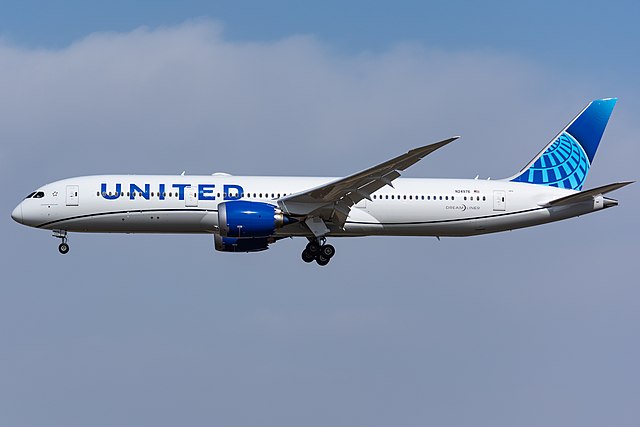Airlines carried 94 percent as many passengers in September 2022 as they did in September 2019, according to passenger counts published by the Transportation Security Administration. That’s up from 91 percent in August and 88 percent in September.
Photo by N509FZ.
According to United Airlines CEO Scott Kirby, the industry is thriving due to changes in leisure travel habits following the pandemic. People who work at home at least some days a week are taking more frequent short pleasure trips for long weekends.
“Hybrid work allows every weekend to be a holiday weekend,” says Kirby. Business travel may be down, both because of the impending recession and because of increased on-line meetings, but this is mostly offset by the increase in recreational travel. Apparently, he says, “It wasn’t money that constrained people from travel” before the pandemic, “it was time.”
This alludes to Marchetti’s constant, the notion that people have a fixed travel-time budget (usually estimated to be about an hour a day). If they spend less time commuting, they have more time in their budget for other kinds of travel.
The main reason why September air travel was 94 percent, instead of more than 100 percent, of pre-pandemic levels, Kirby observes, is the airlines’ limited ability to meet the demand due to supply-chain and labor problems. Air travel will greatly increase, he implies, as the airlines buy more aircraft and hire more employees, both of which United is doing as fast as it can.
Meanwhile, Amtrak is unusually late in publishing its monthly performance report for August. As of July, Amtrak was carrying 84 percent of pre-pandemic numbers, somewhat short of the airlines’ record.
If business travel were down and people were taking Amtrak as well as flying for short leisure trips, we might expect to see travel on long-distance trains (which mostly carry vacation travelers) up relative to travel in the Boston-Washington corridor (which mostly carries business travelers). But we don’t: in July, Northeast Corridor trains carried 87 percent of pre-pandemic numbers, while long-distance trains carried just 78 percent. State-supported trains (which carry a mix of business and vacation travelers) were even worse off at 75 percent.
Telecommuters who are using effectively long weekends for short jaunts are more likely to fly than take a train. A two-day train trip might be a nice part of a two-week vacation, but people are not going to spend most of their four-day weekends en route as doing so would exceed their travel-time budgets. Thus, Amtrak is not likely to benefit as much from the same boom in short vacation trips that the airlines are enjoying.









also, with the train you are fixed on a route and stuck on board. if you drove and something of interest along your trip pops up you can stop and explore…cant do that on a train.
Anyone watch BBC top gear.
The guys attempt to make train travel cheaper, faster and more interesting by replacing the conventional carriages and locomotive with a series of caravans attached to a specially modified car. It’s either the world’s most ingenious idea or the prelude to the world’s biggest accident.
Its….It’s….. not a terrible idea.
Aviation is a highly regulated capital-intensive industry which means, in this context, that they can neither hire and quickly train pilots and mechanics and dispatchers to replace those who retired or left the industry during the pandemic nor buy new aircraft willy-nilly.
You were saying…
https://simpleflying.com/united-airlines-huge-widebody-order-rumours/
Why bring Stacey Abrams into the conversation?
From Aviation Week …
The chief executive of United Airlines has identified three bullish trends that he believes will power the air transport industry through a period of high inflation and global macroeconomic uncertainty.
Those three tailwinds include: a series of ongoing supply constraints that will keep a lid on airline capacity growth rates in the coming years; a shift to hybrid-work schedules that changes how people travel for business and leisure; and the ongoing reopening of many international destinations from pandemic-driven lockdowns.
These three trends are why all airline revenues keep surprising to the upside,” Kirby said.
Because of tight supply, airlines will fly far, fly full and charge high prices. It will be interesting to compare revenue to passenger-air-miles over the next few years.
As for new aircraft (increased capacity) there isn’t much on the near horizon.
There is boom in leisure travel? I don’t buy it. Where re the numbers?
sthomper, good point. At least with an airplane, you can jump out with a parachute if something of interest along your trip pops up. Can’t do that with a train.
This article is interesting. The situation is in flux. The pandemic is NOT over, but I am thinking 10 to 15 years hence. What will be the travel desires of exurbers?
You’ve got 2 to 4 kids plus dogs and a 4,000 to 5,000 sq ft house on 3/4 acre in an area filled with similar housing and plenty of parks and recreational areas and JY’s and YMCA’s etc. Plus, much of your work in telecommuting. You send your kids to camp 2 to 4 weeks each summer. It’s cheaper for grandparents to come to you for holidays.
I don’t know the answer; I’m just asking?